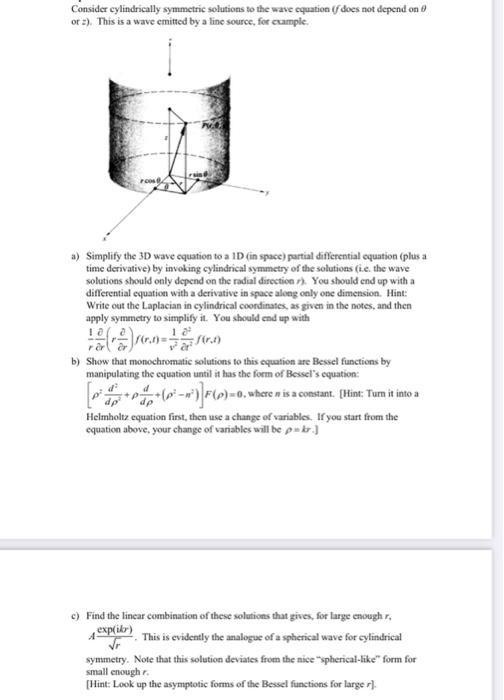Answered step by step
Verified Expert Solution
Question
1 Approved Answer
Consider cylindrically symmetric solutions to the wave equation (f does not depend on or :). This is a wave emitted by a line source,

Consider cylindrically symmetric solutions to the wave equation (f does not depend on or :). This is a wave emitted by a line source, for example. a) Simplify the 3D wave equation to a 1D (in space) partial differential equation (plus a time derivative) by invoking cylindrical symmetry of the solutions (i.e. the wave solutions should only depend on the radial direction ). You should end up with a differential equation with a derivative in space along only one dimension. Hint: Write out the Laplacian in cylindrical coordinates, as given in the notes, and then apply symmetry to simplify it. You should end up with 18 ()1()(0) f(r.)= b) Show that monochromatic solutions to this equation are Bessel functions by manipulating the equation until it has the form of Bessel's equation: d d () F(p=0. >)=0, where n is a constant. (Hint: Turn it into a dp Helmholtz equation first, then use a change of variables. If you start from the equation above, your change of variables will be pabr.] c) Find the linear combination of these solutions that gives, for large enough r, exp(ikr) r This is evidently the analogue of a spherical wave for cylindrical symmetry. Note that this solution deviates from the nice "spherical-like" form for small enough r. [Hint: Look up the asymptotic forms of the Bessel functions for larger]
Step by Step Solution
★★★★★
3.41 Rating (154 Votes )
There are 3 Steps involved in it
Step: 1
Here...
Get Instant Access to Expert-Tailored Solutions
See step-by-step solutions with expert insights and AI powered tools for academic success
Step: 2

Step: 3

Ace Your Homework with AI
Get the answers you need in no time with our AI-driven, step-by-step assistance
Get Started


